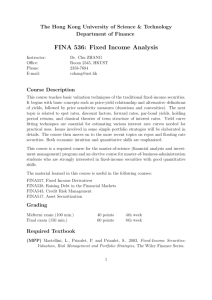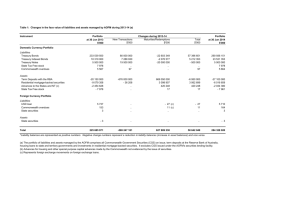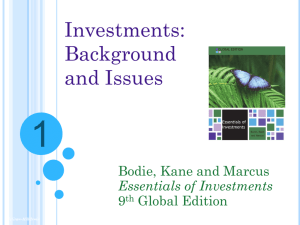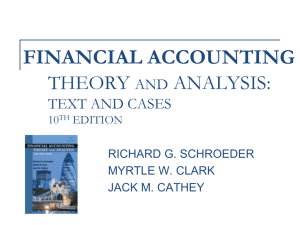Economics 434 Financial Markets - SHANTI Pages
advertisement
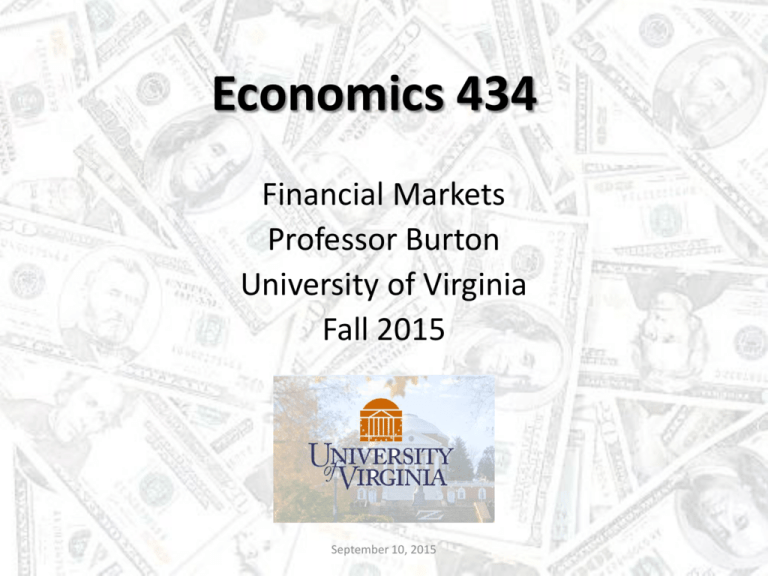
Economics 434 Financial Markets Professor Burton University of Virginia Fall 2015 September 10, 2015 Tomorrow s1 Today s2 s3 And, we may not have any ideaSeptember what the probabilities of s1, s2, s3 may be!! 10, 2015 Fundamental Theorem of Finance • The Assumption of No Arbitrage is True • If and only if • There exist positive state prices (one for each state) that represent the price of a security has a return of one dollar in that state and zero for all other states September 10, 2015 2nd Fundamental Theorem of Finance • State prices exist (not necessarily in the real world) • If and only if • Every security’s price is equal to its returns in each state “priced” by the state price for each state: Pj = Price (of Security j) = (pj,1 * q1) + (pj,2 * q2) + (pj,3 * q3) September 10, 2015 What are the takeaways? • • • That state prices are not necessarily the same for each state. – The available securities and their prices securities determine state prices. If there were a different set of securities, then state prices will generally be different – Determining what is a “good” state and what is a “bad state” will depend upon the available securities. States where virtually all the securities have very positive payoffs is a “good” state, whereas states for which there are few, if any, securities with positive payoffs is a “bad” state. (This is all relative). – State prices for bad states will exceed state prices for good states. (to convince yourself of this, imagine you have a portfolio of securities that do very poorly in the bad state but great in the good state. If someone offered you your choice of state securities, which would you choose?) Diversification is about finding securities with positive payoffs in bad states (not simply about lack of correlation of returns in good states). – Two benefits of diversification • Lowers risk for a given return • Increases potential return for a given level of risk All of this follows from the simple assumption of “no-arbitrage” September 10, 2015 Interpreting the “risk-free” rate and the riskless security September 10, 2015 The Risk Free Security • Imagine a portfolio that consisted only of one of each of the state price securities: Q1, Q2, Q3 with prices q1, q2, q3. (Call this portfolio, Q, which consists of one unit of each state prices security). • That portfolio, Q, would return exactly $ 1 regardless of which state occurred – that means that portfolio would be the riskless asset. • Price of Q, the riskless asset = q = q1 + q2 + q3 • Risk free rate = r = 1−𝑞 𝑞 = 1 𝑞 − 1 so that q = September 10, 2015 1 1+𝑟 Interpreting the risk free rate • What is the value today of $ 1 that I will receive tomorrow? • Answer: $1 1+𝑟 • This is called “discounting”. You are discounting $ 1 tomorrow back to it’s present value. You use r because you want to be absolutely certain what a dollar tomorrow is worth • The more uncertain you are to get the $ 1 tomorrow the higher would be the discount rate • Lowest possible discount rate is r, for absolutely certain outcomes. • Same logic applies to all future periods. For example, the value now of $ 1 that will be received two periods from now: • $1 1+𝑟 2 September 10, 2015 Create pseudo-probabilities (risk adjusted probabilities) • Define πi = 𝑞𝑖 𝑞 (recall that qi is the ith state price and q is the sum of all state prices) • Then: πi > 0 for all I π1 + π2 + π3 = 1 This looks like probabilities for each state! In fact, these πi ‘s are called “risk-adjusted probabilities” September 10, 2015 The Pricing of Security j Pj = = 1 1+𝑟 𝑝𝑗,1 ∗ 𝜋1 + 𝑝𝑗,2 ∗ 𝜋2 + 𝑝𝑗,3 ∗ 𝜋3 price equals discounted expected value! September 10, 2015 Do We Really Not Need Actual Probabilities of Each State? • The “state price” view requires knowledge of existing security prices (required to verify the no-arbitrage condition) • How are these security prices determined? • We don’t really know that until we decide on a “market model” that determines security prices September 10, 2015 Two Main “Market Model” Candidates • Capital Asset Pricing Model (CAPM) – William Sharpe etal, 1962 – Two parameter theory • Mean, variances of returns • But, concludes that “covariances” drive pricing (through betas) – Terminology widely used in all of finance • Arbitrage Pricing Theory (APT) – Steve Ross, 1982 – Father of “multi-factor” models • Widely used in Asset Management industry • Mainly regressions of returns on explanatory variables – Special case of APT is CAPM September 10, 2015 September 10, 2015

